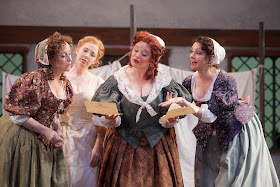Falstaff, Verdi’s final opera based on William Shakespeare’s The Merry Wives of Windsor and Henry IV, Parts I & II, owes much to librettist Arrigo Boito’s wonderfully structured and witty adaptation concerning the Bard’s “great whale of Windsor”, the big-bellied knight John Falstaff whose attempts to seduce two married women come to a mocking end. And layered with the composer’s swift, narrative-enriching music, the libretto’s inbuilt comic charms bristle with opportunity for directorial enlivenment.
 |
| Andrew Hiers, Nathan Ward and Olafur Sigurdarson as Falstaff |
In its simple and straightforward rustic setting, the comedy percolated through seamlessly. Stephen D. Mazzeno’s set design, featuring a large Tudor-esque two-dimensional wall with lead light windows and timber strapping, fills the stage and is neatly utilised for both interior and exterior settings with either the addition of a staircase (for Act 1’s Garter Inn and a room in Alice Ford’s house in Act 2) or potted hedged greenery (Act 1, Scene 2’s garden in front of Alice Ford’s house). Falstaff’s ditching in the Thames at Act 2’s end comes across rather clumsily on a sheath of blue cloth and, with just a silhouetted oak tree and low lying distant crenellations for Act 3’s Windsor Park, the overall concept relies on economy of means. It does the job with humble honesty - though without inspired sophistication - as do Clare Mitchell’s variety of fabric-laden village costumes and Lucas Krech’s mostly warm obedient lighting.
Edwards uses the space broadly and has the fortune of a spirited cast with strong acting chops at his disposal. Led by Icelandic baritone Olafur Sigurdarson’s adroitly caricatured vocal largesse and the paunchiness to go with it, Falstaff took larger than life form in Sigurdarson’s experienced grip.
 |
| Olafur Sigurdarson as Falstaff and Cynthia Clayton as Alice Ford |
And Sigurdarson always looked at ease in the title role’s weighty and complex demands, bringing a cheeky comic agility to an otherwise slovenly lump. And how the voice projected with resonant strength and bucolic depth as if supported by the great mass below. The use of text was superb and the expression to match made a gourmet performance. Then there was the fine falsetto to cap off his character’s own derisive comments. Here was a fully-studied and naturally drawn interpretation that has years of delight to give.
Alongside Sigurdarson, some noteworthy voices shone. At the top of the list for unwavering consistency and interpretation, there was silken soprano Susannah Biller as the winsome ingénue Nannetta, hearty mezzo-soprano Dana Beth Miller as the nettlesome Dame Quickly and grainy, robust bass-baritone Andrew Hiers as Falstaff’s thieving double-crosser, Pistola.
 |
| Cynthia Clayton, Susannah Biller Dana Beth Miller, Sandra Piques Eddy |
One of the performance highlights was the comic spark set off between Miller’s Dame Quickly and Sigurdarson’s Falstaff with voices matching so marvellously you might have wondered whether an amorous rendezvous would come too. The ladies’ front-of-stage lineup in Act 1, as they decide to punish Falstaff after Meg and Alice receive the same love letter, is a vibrantly sung and gesticulated affair but when the larger ensemble fronted, the quick-tempo demands invariably lost tightness and form. From below, conductor Ari Pelto kept the drama well lubricated, its three acts (including two intervals) moving tautly at a swift pace with the Opera Colorado Orchestra in overall good command.
Conceived without show-stopping and stand-and-deliver arias, Verdi’s Falstaff makes for a fortuitous encounter with Shakespeare’s rotund indelible character and, on that account with Sigurdarson in the picture, Opera Colorado have delivered in spades.
Falstaff
Opera Colorado
Ellie Caulkins Opera House
Until 13th May, 2018
Production Photos: Matthew Staver
No comments:
Post a Comment